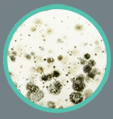Mold vs. Mildew
Mold and mildew are often confused for each other because they share many of
the same qualities, but they also differ in key ways. It is important to be able to
tell the difference between mold and mildew because they require different
approaches in order to remove them. And you do want to remove them as soon
as possible because they can cause health issues and damage to the structural
integrity of your home if they are left alone to fester and grow.
As for the similarities, they are both members of the fungi family, which means
they share some basic core traits such as the ability to get nutrients through
absorption. Additionally, they both grow when wet conditions are present. If you
want to avoid mold and mildew appearing in your home you should make sure
there is not any water leakage or excess condensation around the house,
because a little moisture is all mold and mildew need to grow.
Now for some distinguishing factors. Whereas mildew will grow flat along the surface of a material, mold has the ability to burrow deep into materials like food, drywall, and wood. So for example, just because you cut off a portion of a piece of bread where you spotted mold does not mean the mold has not spread into more parts of that piece of bread and you may not want to eat it. Typically, mildew appears in gray or white and has a powdery texture. Mold can be found in many colors including black, white, yellow, green, and even pink and has a slimy or fuzzy texture.
Both can be significant issues for a homeowner and those living inside of the
home. Mold can break down materials that make up the structure of a house
like wood and drywall and compromise the integrity of the building. As far as
health problems, mold can cause a wide range of issues for individuals exposed
to it including headaches, allergic reactions, respiratory issues, exhaustion, joint
pain, dizziness, neurological issues, and heart problems. The individuals most at
risk are babies and kids, older folks, and those with weak immune systems.
Exposure to mildew can also cause headaches, respiratory issues, and sore
throat. The longer the exposure occurs the worse it can get and the more
people it can affect. Therefore, quick action is imperative.
 Since mildew is usually just on surface of a material, it can be cleaned
up easily with household products and some scrubbing. If you are lucky
and caught a small mold infestation early on a hard surface, then this
may be all you need to get rid of mold in your home. But if there has
been significant spreading and the mold has burrowed into porous
materials, you may need to call in a professional mold removal team.
Keeping the more moisture-rich areas of your home, such as the bathroom, basement, and kitchen, well-ventilated and monitored
is key to preventing mold and mildew growth in your home.
Since mildew is usually just on surface of a material, it can be cleaned
up easily with household products and some scrubbing. If you are lucky
and caught a small mold infestation early on a hard surface, then this
may be all you need to get rid of mold in your home. But if there has
been significant spreading and the mold has burrowed into porous
materials, you may need to call in a professional mold removal team.
Keeping the more moisture-rich areas of your home, such as the bathroom, basement, and kitchen, well-ventilated and monitored
is key to preventing mold and mildew growth in your home.
Comparison Chart
Below is a simple chart that depicts some of the main similarities and differences between mold and mildew. The embed code is listed below the graphic if you are interested in using it.
- Mold

- Mildew
- Texture

slimy or fuzzy
Powdery

Both arE Fungi

- colors
- Black
- White
- Yellow
- Green
- Pink
- Gray
- White
- Black
- Yellow
- Brown
- picture


Both love
Damp
Environments
- Growth
patternburrows under
the surface

grows flat on
the surface - exposure
symptoms
respiratory

neurological

joint pain

headache

allergic
reaction
heart

headache

Respiratory issues

sore throat
both can grow
on virtually any surface
- how to
removeMay need professional
Help
easily cleaned with
household products
















